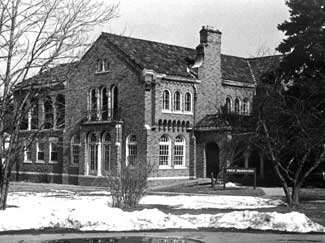Main Content
Article
Secretary of the Interior's Standards for Preservation

Saint Vincent Villa
Fort Wayne, IN
The Secretary of the Interior is responsible for establishing standards for all national preservation programs under Departmental authority and for advising federal agencies on the preservation of historic properties listed or eligible for listing in the National Register of Historic Places.
The Standards for Rehabilitation, a section of the Secretary of the Interior’s Standards for Historic Preservation, address the most prevalent preservation treatment of today: rehabilitation activities. Rehabilitation is defined as “the process of returning a property to a state of utility, through repair or alteration, which makes possible an efficient contemporary use while preserving those portions and features of the property which are significant to its historic, architectural, and cultural values.”
The Standards that follow were originally published in 1977 and were revised in 1990 as part of Department of the Interior regulations (36 CFR Part 67, Historic Preservation Certifications). They pertain to historic buildings of all materials, sizes, construction types, and occupancy, and they encompass both the exterior and interior of historic buildings. The Standards also apply to related landscape features and the building’s site and environment as well as attached, adjacent, or related new construction.
The Standards are to be applied to specific rehabilitation projects in a reasonable manner, taking into consideration economic and technical feasibility. In brief, the Standards cover the following ten points:
- A property shall be used for its historic purpose or be placed in a new use that requires minimal change to the defining characteristics of the building and its site and environment.
- The historic character of a property shall be retained and preserved. The removal of historic materials or alteration of features and spaces that characterize a property shall be avoided.
- Each property shall be recognized as a physical record of its time, place, and use. Changes that create a false sense of historical development, such as adding conjectural features or architectural elements from other buildings, shall not be undertaken.
- Most properties change over time; those changes that have acquired historic significance in their own right shall be retained and preserved.
- Distinctive features, finishes, and construction techniques or examples of craftsmanship that characterize a property shall be preserved.
- Deteriorated historic features shall be repaired rather than replaced. Where the severity of deterioration requires replacement of a distinctive feature, the new feature shall match the old in design, color, texture, and other visual qualities and, where possible, materials. Replacement of missing features shall be substantiated by documentary, physical, or pictorial evidence.
- Chemical or physical treatments, such as sandblasting, that cause damage to historic materials shall not be used. The surface cleaning of structures, if appropriate, shall be undertaken using the gentlest means possible.
- Significant archaeological resources affected by a project shall be protected and preserved. If such resources must be disturbed, mitigation measures shall be undertaken.
- New additions, exterior alterations, or related new construction shall not destroy historic materials that characterize the property. The new work shall be differentiated from the old and shall be compatible with the massing, size, scale, and architectural features to protect the historic integrity of the property and its environment.
- New additions and adjacent or related new construction shall be undertaken in such a manner that if removed in the future, the essential form and integrity of the historic property and its environment would be unimpaired.
Certain treatments, if improperly applied, or certain materials by their physical properties, may cause physical deterioration of historic buildings. Inappropriate physical treatments include, but are not limited to: improper repointing techniques; improper exterior masonry cleaning methods; and improper introduction of insulation where damage to historic fabric would result. In almost all situations, use of these materials and treatments will result in denial of certification for tax credit purposes. In addition, every effort should be made to ensure that new materials and workmanship are compatible with the materials and workmanship of the historic property.
The Secretary of the Interior’s Standards for the Treatment of Historic Properties have been expanded and interpreted to cover a wide variety of preservation situations and issues. Specifically, the Standards cover acquisition, protection, stabilization, preservation, rehabilitation, restoration, and reconstruction. When researching these Standards or requesting copies, it is important to know which subset of the Standards apply to your situation.
For more information, or to receive a copy of the Secretary of the Interior’s Standards for Historic Preservation Projects, contact the DHPA or write to: National Park Service, Heritage Preservation Services, 1849 C Street, N.W., Washington, D.C. 20240.
